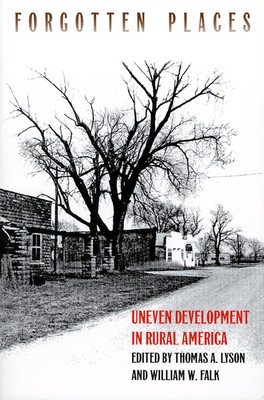
- We will send in 10–14 business days.
- Publisher: University Press Of Kansas
- ISBN-10: 0700605932
- ISBN-13: 9780700605934
- Format: 15.4 x 22.9 x 2.1 cm, softcover
- Language: English
- SAVE -10% with code: EXTRA
Forgotten Places (PB) (e-book) (used book) | bookbook.eu
Reviews
Description
On the surface they look very different--rugged northern New England with its primarily White population, the arid Lower Rio Grande Valley inhabited mainly by Hispanics, the green and humid Mississippi Delta with a mix of Black and White residents. But when it comes to economics, they have much in common--fortune passed them by.
Along with other predominantly rural regions, these areas have fallen behind the rest of the United States in many ways, from job opportunity and education to health care and living conditions. In Forgotten Places, Thomas Lyson and William Falk have brought together works by regional experts on some of the major forgotten places throughout the country: northern New England, the Lower Rio Grande Valley, the Delta, Appalachia, the southern Black belt, the "flannel shirt frontier" of Oregon, the Ozarks, the Upper Peninsula of Michigan, and rural California. In these essays, the authors focus on problems that keep the regions below the national average in income and standard-of-living surveys. Although the dilemmas vary--a pre-abolition caste system retained in the Mississippi Delta; expendable resources from lumber to lead that have been nearly expended in such places as Ontonagon, Michigan and Oakridge, Oregon; and large farming operations that utilize low-paid, immigrant labor in California--the predicaments are often the same. High illiteracy, dead-end jobs, lack of adequate health care, poor housing conditions, lack of industry and capital, and inability to influence government policy have too often perpetuated a vicious circle of poverty for many people in forgotten places. Each chapter, focusing on a different region, examines why the area languished during an era of economic growth; what social, economic, and political forces contributed to uneven development and poverty; what government has done to alleviate uneven development and lack of opportunity; current social and economic conditions; and locally based attempts to enhance economic development. And after delving into the past and present, the causes and the consequences, the authors speculate on what the future may bear.EXTRA 10 % discount with code: EXTRA
The promotion ends in 19d.23:46:06
The discount code is valid when purchasing from 10 €. Discounts do not stack.
- Publisher: University Press Of Kansas
- ISBN-10: 0700605932
- ISBN-13: 9780700605934
- Format: 15.4 x 22.9 x 2.1 cm, softcover
- Language: English English
On the surface they look very different--rugged northern New England with its primarily White population, the arid Lower Rio Grande Valley inhabited mainly by Hispanics, the green and humid Mississippi Delta with a mix of Black and White residents. But when it comes to economics, they have much in common--fortune passed them by.
Along with other predominantly rural regions, these areas have fallen behind the rest of the United States in many ways, from job opportunity and education to health care and living conditions. In Forgotten Places, Thomas Lyson and William Falk have brought together works by regional experts on some of the major forgotten places throughout the country: northern New England, the Lower Rio Grande Valley, the Delta, Appalachia, the southern Black belt, the "flannel shirt frontier" of Oregon, the Ozarks, the Upper Peninsula of Michigan, and rural California. In these essays, the authors focus on problems that keep the regions below the national average in income and standard-of-living surveys. Although the dilemmas vary--a pre-abolition caste system retained in the Mississippi Delta; expendable resources from lumber to lead that have been nearly expended in such places as Ontonagon, Michigan and Oakridge, Oregon; and large farming operations that utilize low-paid, immigrant labor in California--the predicaments are often the same. High illiteracy, dead-end jobs, lack of adequate health care, poor housing conditions, lack of industry and capital, and inability to influence government policy have too often perpetuated a vicious circle of poverty for many people in forgotten places. Each chapter, focusing on a different region, examines why the area languished during an era of economic growth; what social, economic, and political forces contributed to uneven development and poverty; what government has done to alleviate uneven development and lack of opportunity; current social and economic conditions; and locally based attempts to enhance economic development. And after delving into the past and present, the causes and the consequences, the authors speculate on what the future may bear.

Reviews